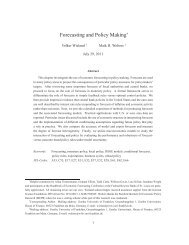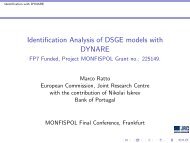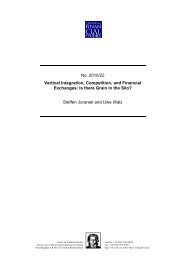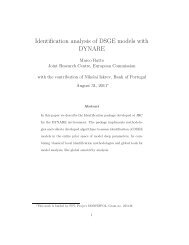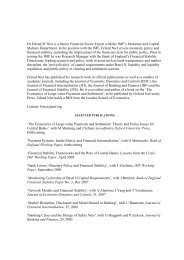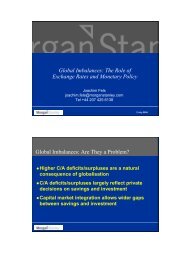r. david mclean, jeffrey pontiff and akiko watanabe - Center for ...
r. david mclean, jeffrey pontiff and akiko watanabe - Center for ...
r. david mclean, jeffrey pontiff and akiko watanabe - Center for ...
You also want an ePaper? Increase the reach of your titles
YUMPU automatically turns print PDFs into web optimized ePapers that Google loves.
data prior to the listed start dates to construct some of the variables that are described in the<br />
following subsection. To be included in our sample, a stock must have sufficient in<strong>for</strong>mation<br />
to generate the annual issuance measure (explained below), market value of equity, lagged<br />
six-month holding period return, <strong>and</strong> current month’s return. Each month we limit our<br />
sample to countries that have at least 50 firm observations in that month.<br />
Our final sample consists of 2,819,906 total firm-month observations (see column 4<br />
of Table 1). Japan represents the largest part of our sample, accounting <strong>for</strong> 14.72% of the<br />
total observations (column 5) <strong>and</strong> 29.56% of the total market value per month (column 9).<br />
The United Kingdom is the second largest <strong>and</strong> accounts <strong>for</strong> 13.27% of the total observations<br />
<strong>and</strong> 11.68% of the total market value. The rest of the countries typically accounts <strong>for</strong> less<br />
than 5% of the total observations <strong>and</strong> market value.<br />
1.2. Variables<br />
Share issuance. The main variable of our interest is the real change in shares<br />
outst<strong>and</strong>ing, or the change in the number of shares outst<strong>and</strong>ing adjusted <strong>for</strong> distribution<br />
events such as stock splits <strong>and</strong> stock dividends. We use the capital adjustment index from<br />
Datastream recorded at the end of month t (CAIt) to calculate the number of real shares<br />
outst<strong>and</strong>ing <strong>for</strong> that month (Adjusted Sharest). The CAI is the cumulative product of the<br />
inverse of the individual-period capital adjustment factor (AX) <strong>and</strong> is analogous to the Total<br />
Factor of Pontiff <strong>and</strong> Woodgate (2006):<br />
CAIt = ∏<br />
i=<br />
t<br />
1<br />
1 /AXi<br />
.<br />
Adjusted Sharest is then given by:<br />
Adjusted Sharest = Shares Outst<strong>and</strong>ingt / CAIt.<br />
5



